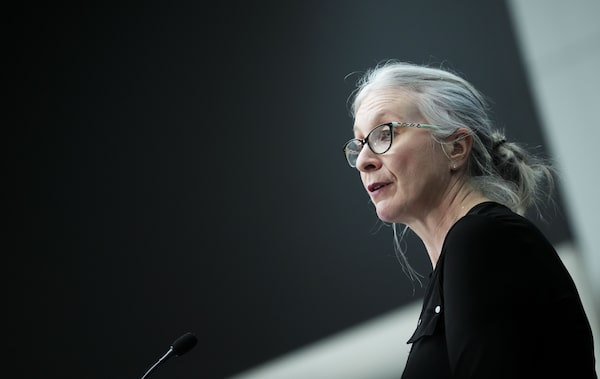
Minister of Indigenous Services Patty Hajdu speaks in Ottawa on May 16, 2022. Hajdu is urging the Nunavut government and the territory’s top Inuit organization to sign a plan for combatting tuberculosis as soon as possible.Sean Kilpatrick/The Canadian Press
Federal Indigenous Services Minister Patty Hajdu is urging the government of Nunavut and the territory’s top Inuit organization to sign a long-delayed plan for combatting tuberculosis as soon as possible, a step that could lead to more federal money being earmarked to fight the infectious disease, which continues to plague Inuit communities.
“I would really hope that they conclude those negotiations quickly so that that plan is in place and we can assess what’s needed for budget 2023,” Ms. Hajdu said in an interview.
A recent Globe and Mail investigation revealed that front-line nurses in the Baffin Island hamlet of Pangnirtung were begging for help last summer as tuberculosis spread in the community of 1,500 people. There were 139 cases diagnosed there between January, 2021, and May of this year, 31 of them active cases that made patients sick and infectious. The rest were latent infections, which put people at risk of getting sick with active TB in the future.
Nunavut admits to large tuberculosis outbreak in Pangnirtung months later
It is the largest TB outbreak to be publicly disclosed in Nunavut since 2017.
As cases were mounting in Pangnirtung, most of a $13-million federal fund for fighting tuberculosis in Nunavut went unspent because Inuit organization Nunavut Tunngavik Inc. (NTI), the recipient of the money, couldn’t agree with the territorial government on a plan for spending it.
The Trudeau government committed the money in 2018, when it promised to eliminate tuberculosis in Inuit communities by 2030.
Ms. Hajdu said she had urged Nunavut Health Minister John Main to work with NTI to conclude the talks swiftly and sign an agreement.
“I just said, ‘Look, at the end of the day, we have an ambitious strategy that aims to eliminate tuberculosis across Inuit Nunangat by 2030,’” Ms. Hajdu said, using the term for Inuit lands in Canada. “When you have targets like that, then you need specific sorts of milestones. And so I asked him to be really, really focused on supporting the work of NTI, who do have a very thorough plan.”
Mr. Main told The Globe that negotiations at the staff level are going well, and that he believes a deal is close. “My understanding is that we’re on a pretty good track now to formalize things in the next month or two,” he said.
When Ottawa promised in 2018 to stamp out TB in Inuit communities, it gave $27.5-million over five years to the national organization Inuit Tapiriit Kanatami. ITK divided the funding among four Inuit regions, including Nunavut, which is home to more Inuit than the other three regions combined.
Inuit leaders in each region were supposed to work with local government officials to adopt TB plans tailored to their needs. Only Nunavut has failed to finalize an agreement.
NTI’s president, Aluki Kotierk, told The Globe in July that the main sticking point is the Nunavut Department of Health’s refusal to publish TB case counts by community, as it did with COVID-19 cases. This would allow the Inuit organization to measure progress toward elimination and send aid to the communities that need it most.
Although Mr. Main said he was hopeful a plan would soon be signed, he wouldn’t promise to make community-level TB statistics public. (He and the Department of Health made an exception in the case of the Pangnirtung outbreak after The Globe made a reporting trip to the community in May and Eric Lawlor, the hamlet’s mayor, asked for transparency. At the same time, the department said the outbreak’s curve was flattening, a hopeful sign.)
Mr. Main said releasing community-level TB numbers risks inadvertently identifying individuals and stigmatizing entire hamlets. “We don’t want people to suffer because they’re already suffering in terms of their health,” he said.
Mr. Main and Ms. Hajdu both stressed that tackling TB requires improving the conditions that make the disease more prevalent in Inuit communities than anywhere else in Canada, including overcrowded housing, food insecurity, entrenched poverty and limited local medical care.
Pangnirtung is a case in point: The community is dealing with the closure of its health centre from Aug. 1 to Aug. 7 because of a shortage of nurses. Paramedics will be on site to handle emergencies, and a TB clinic in the hamlet’s community hall will continue to operate during the closure, Mr. Main said.
Nunavut Senator Dennis Patterson called the small satellite clinic in Pangnirtung a much less aggressive response than the community-wide screening that took place in 2018 in Qikiqtarjuaq, the site of the territory’s last major TB outbreak.
“It’s extremely significant and alarming and disappointing to see the trends are clearly going in the opposite direction,” he said of TB rates in Nunavut. “We have rising incidence and Pangnirtung is the poster child of that.”
Hunting for healthy food in Nunavut
Pangnirtung Deputy Mayor Markus Wilcke said he was discouraged that no politicians from the federal or territorial governments have reached out to hamlet leaders this summer about the TB outbreak.
“We have not received a call from either the Minister of Health or any politician from the federal government,” Mr. Wilcke said. “I just kind of thought that maybe there would be some response on that level, directly to the community. But that didn’t happen.”
The Globe and Mail’s health reporter Kelly Grant is taking an in-depth look at health care in Nunavut and the challenges its residents face accessing it. Over the course of 2022, she’ll examine why the territory’s residents have some of the worst health outcomes in the country and what changes are needed to deliver better care.If you have information to help inform The Globe’s reporting on Nunavut, please e-mail kgrant@globeandmail.com